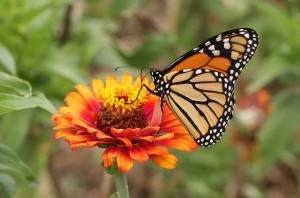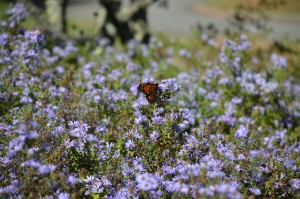From Canada to Mexico, gardeners are being recruited to halt the decline of the Monarch butterfly populations across North America. One way you can help is to fill your garden with Monarch’s favorite flowering nectar plants and milkweeds (Asclepias spp.). Plants should be sited in open full sun and in moist well-drained soil. Avoid spraying pesticides within several hundred square feet of the designated “landing zone” for butterflies.
Nectar plants are the food source that nourishes the adult butterflies. Butterflies feed on their sweet nectar and also aid in pollinating flowers. Select brightly colored flowers which are native to your area. Common nectar plants for monarchs include blackeyed Susan (Rudbeckia spp.), beebalm (Monarda spp.), anise hyssop (Agastache spp.), cosmos (Cosmos spp.), aster (Symphyotrichum spp.), purple coneflower (Echinacea purpurea), lantana, Mexican sunflower (Tithonia), ironweed (Vernonia lettermannia), marigold (Tagetes spp.), tall growing sedums (Sedum spectabile), Joe-Pye (Eupatorium spp.), blazing star (Liatris spp.), salvias (Salvia spp.), and zinnia (Zinnia spp.).
Add specific larval-host feeding plants to attract more butterflies to your garden. Butterfly (adults) lay their eggs on specific larval-host plant species. In the case of Monarch caterpillars, the favorite host plants are the milkweeds (Asclepias spp.) to include common milkweed (A. syriaca), swamp milkweed (A. incarnata), showy milkweed (A. speciosa), tropical milkweed or “bloodflower” (A. curassavica), and butterfly milkweed (A. tuberosa). As its common name indicates, bloodflower is a tender perennial or an annual in zones 9-11.
For maximum visitations, add several kinds of flowering plants with staggered bloom times to keep butterflies coming back to your garden spring thru autumn. The local garden center may offer additional kinds of plants not listed here. On-line nurseries offer species of plants that are rarely found at retail garden centers.
Do your part to help rebuild the monarch population by planting colorful milkweeds and native nectar plants in your garden this coming spring.



 Posted in
Posted in 
